LINCOLN MKZ HYBRID 2014 Owners Manual
Manufacturer: LINCOLN, Model Year: 2014, Model line: MKZ HYBRID, Model: LINCOLN MKZ HYBRID 2014Pages: 445, PDF Size: 3.8 MB
Page 151 of 445
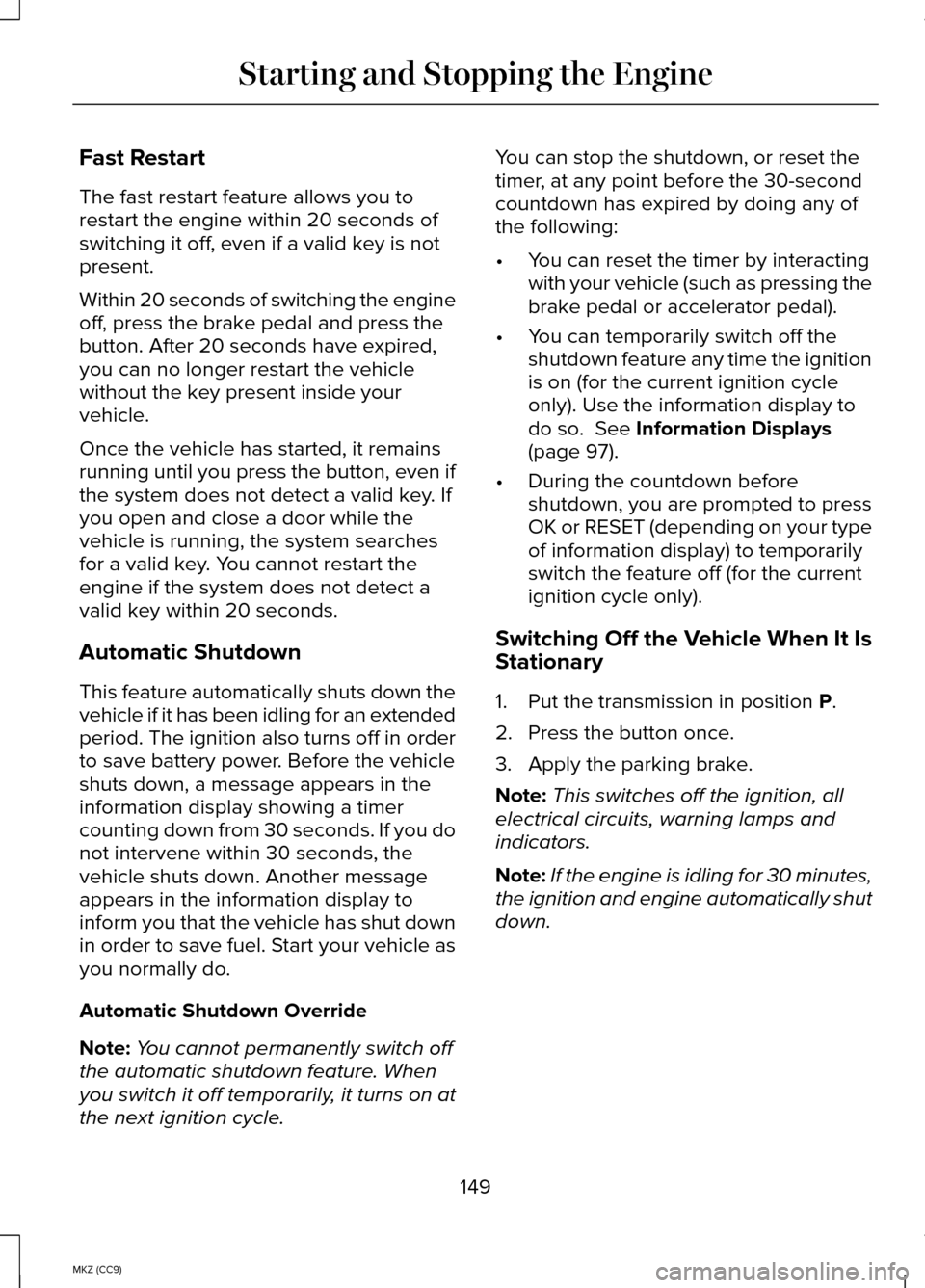
Fast Restart
The fast restart feature allows you to
restart the engine within 20 seconds of
switching it off, even if a valid key is not
present.
Within 20 seconds of switching the engine
off, press the brake pedal and press the
button. After 20 seconds have expired,
you can no longer restart the vehicle
without the key present inside your
vehicle.
Once the vehicle has started, it remains
running until you press the button, even if
the system does not detect a valid key. If
you open and close a door while the
vehicle is running, the system searches
for a valid key. You cannot restart the
engine if the system does not detect a
valid key within 20 seconds.
Automatic Shutdown
This feature automatically shuts down the
vehicle if it has been idling for an extended
period. The ignition also turns off in order
to save battery power. Before the vehicle
shuts down, a message appears in the
information display showing a timer
counting down from 30 seconds. If you do
not intervene within 30 seconds, the
vehicle shuts down. Another message
appears in the information display to
inform you that the vehicle has shut down
in order to save fuel. Start your vehicle as
you normally do.
Automatic Shutdown Override
Note:
You cannot permanently switch off
the automatic shutdown feature. When
you switch it off temporarily, it turns on at
the next ignition cycle. You can stop the shutdown, or reset the
timer, at any point before the 30-second
countdown has expired by doing any of
the following:
•
You can reset the timer by interacting
with your vehicle (such as pressing the
brake pedal or accelerator pedal).
• You can temporarily switch off the
shutdown feature any time the ignition
is on (for the current ignition cycle
only). Use the information display to
do so. See Information Displays
(page 97).
• During the countdown before
shutdown, you are prompted to press
OK or RESET (depending on your type
of information display) to temporarily
switch the feature off (for the current
ignition cycle only).
Switching Off the Vehicle When It Is
Stationary
1. Put the transmission in position
P.
2. Press the button once.
3. Apply the parking brake.
Note: This switches off the ignition, all
electrical circuits, warning lamps and
indicators.
Note: If the engine is idling for 30 minutes,
the ignition and engine automatically shut
down.
149
MKZ (CC9) Starting and Stopping the Engine
Page 152 of 445
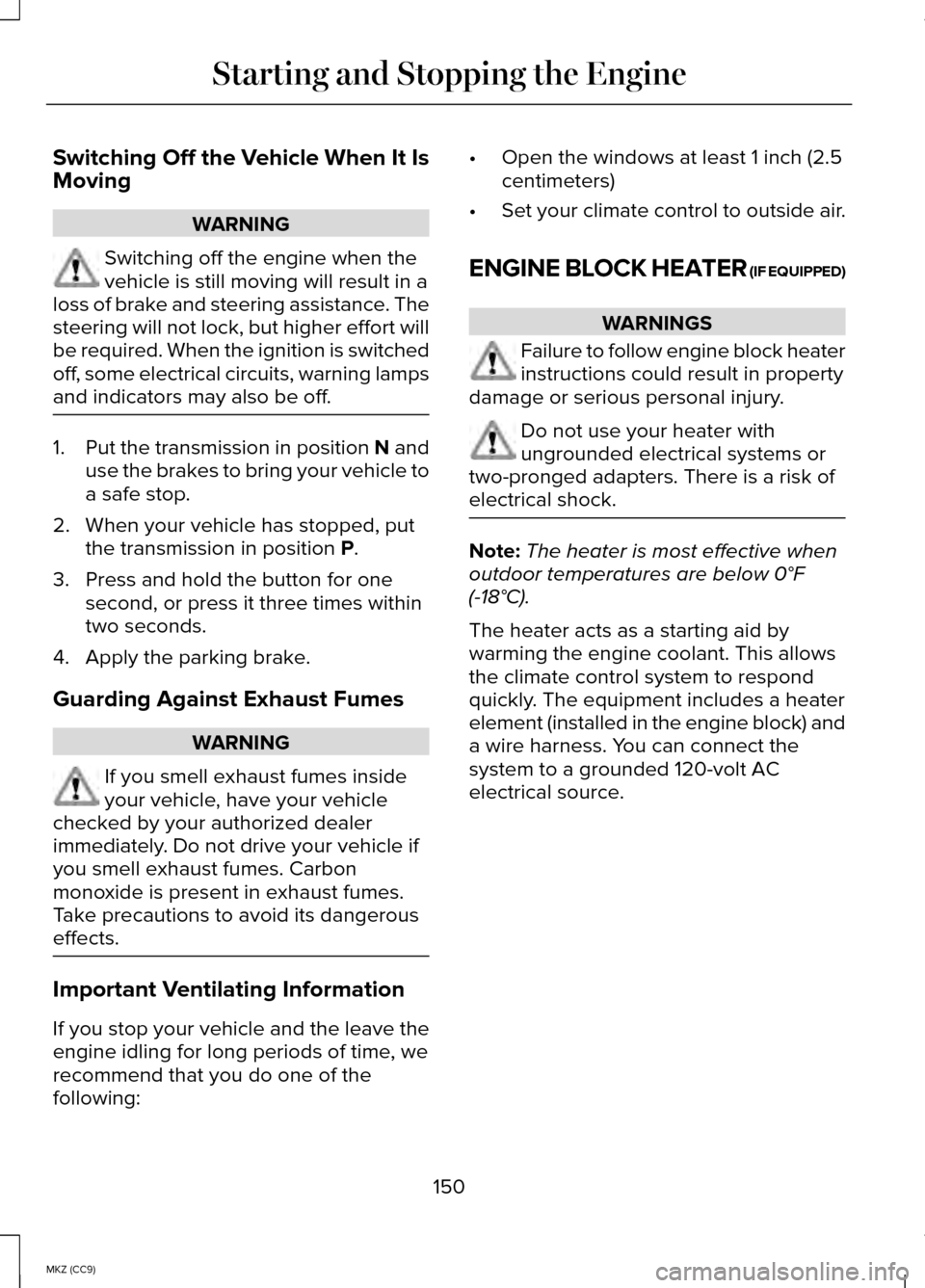
Switching Off the Vehicle When It Is
Moving
WARNING
Switching off the engine when the
vehicle is still moving will result in a
loss of brake and steering assistance. The
steering will not lock, but higher effort will
be required. When the ignition is switched
off, some electrical circuits, warning lamps
and indicators may also be off. 1.
Put the transmission in position N and
use the brakes to bring your vehicle to
a safe stop.
2. When your vehicle has stopped, put the transmission in position P.
3. Press and hold the button for one second, or press it three times within
two seconds.
4. Apply the parking brake.
Guarding Against Exhaust Fumes WARNING
If you smell exhaust fumes inside
your vehicle, have your vehicle
checked by your authorized dealer
immediately. Do not drive your vehicle if
you smell exhaust fumes. Carbon
monoxide is present in exhaust fumes.
Take precautions to avoid its dangerous
effects. Important Ventilating Information
If you stop your vehicle and the leave the
engine idling for long periods of time, we
recommend that you do one of the
following: •
Open the windows at least 1 inch (2.5
centimeters)
• Set your climate control to outside air.
ENGINE BLOCK HEATER (IF EQUIPPED) WARNINGS
Failure to follow engine block heater
instructions could result in property
damage or serious personal injury. Do not use your heater with
ungrounded electrical systems or
two-pronged adapters. There is a risk of
electrical shock. Note:
The heater is most effective when
outdoor temperatures are below 0°F
(-18°C).
The heater acts as a starting aid by
warming the engine coolant. This allows
the climate control system to respond
quickly. The equipment includes a heater
element (installed in the engine block) and
a wire harness. You can connect the
system to a grounded 120-volt AC
electrical source.
150
MKZ (CC9) Starting and Stopping the Engine
Page 153 of 445
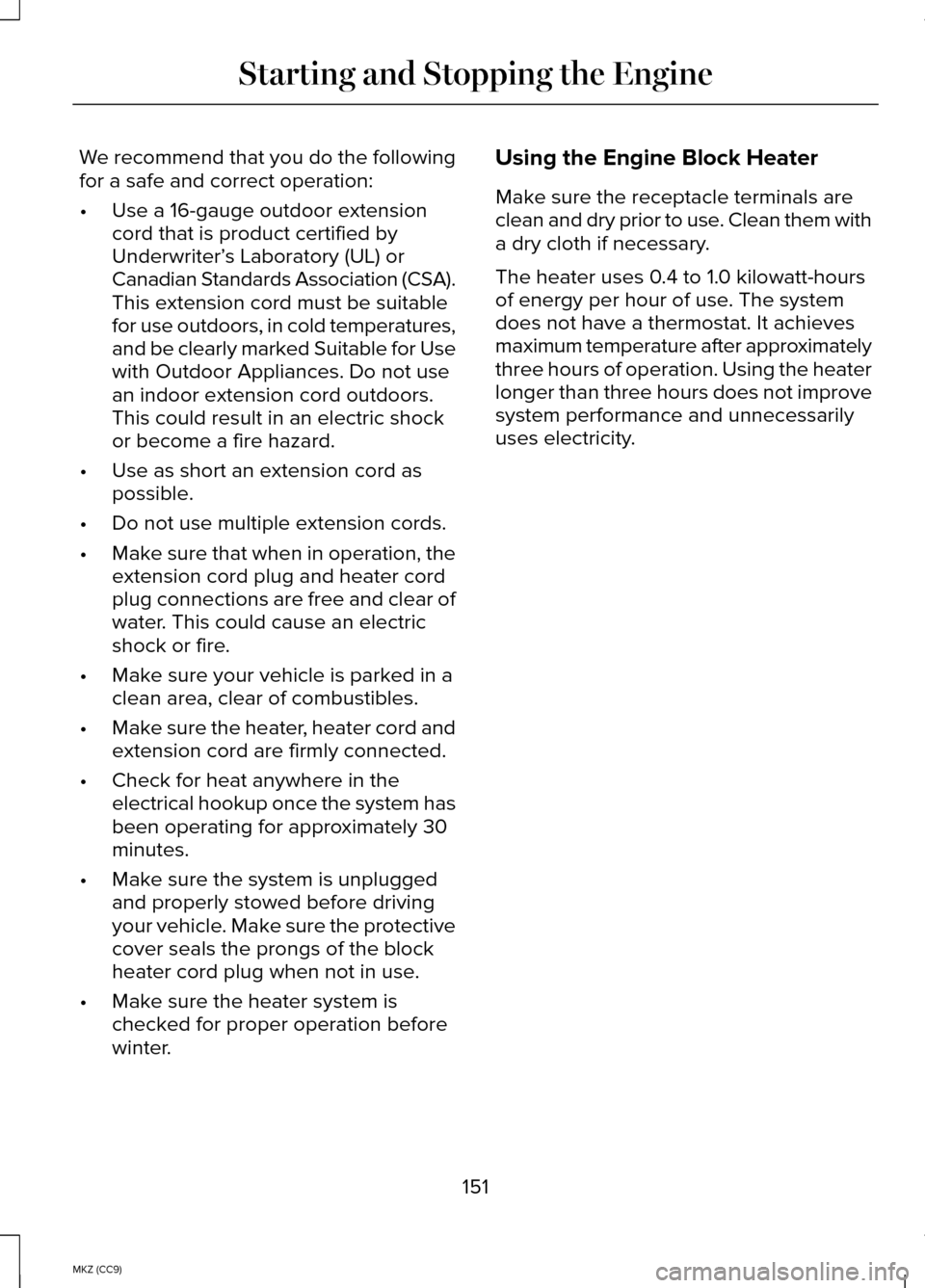
We recommend that you do the following
for a safe and correct operation:
•
Use a 16-gauge outdoor extension
cord that is product certified by
Underwriter’ s Laboratory (UL) or
Canadian Standards Association (CSA).
This extension cord must be suitable
for use outdoors, in cold temperatures,
and be clearly marked Suitable for Use
with Outdoor Appliances. Do not use
an indoor extension cord outdoors.
This could result in an electric shock
or become a fire hazard.
• Use as short an extension cord as
possible.
• Do not use multiple extension cords.
• Make sure that when in operation, the
extension cord plug and heater cord
plug connections are free and clear of
water. This could cause an electric
shock or fire.
• Make sure your vehicle is parked in a
clean area, clear of combustibles.
• Make sure the heater, heater cord and
extension cord are firmly connected.
• Check for heat anywhere in the
electrical hookup once the system has
been operating for approximately 30
minutes.
• Make sure the system is unplugged
and properly stowed before driving
your vehicle. Make sure the protective
cover seals the prongs of the block
heater cord plug when not in use.
• Make sure the heater system is
checked for proper operation before
winter. Using the Engine Block Heater
Make sure the receptacle terminals are
clean and dry prior to use. Clean them with
a dry cloth if necessary.
The heater uses 0.4 to 1.0 kilowatt-hours
of energy per hour of use. The system
does not have a thermostat. It achieves
maximum temperature after approximately
three hours of operation. Using the heater
longer than three hours does not improve
system performance and unnecessarily
uses electricity.
151
MKZ (CC9) Starting and Stopping the Engine
Page 154 of 445
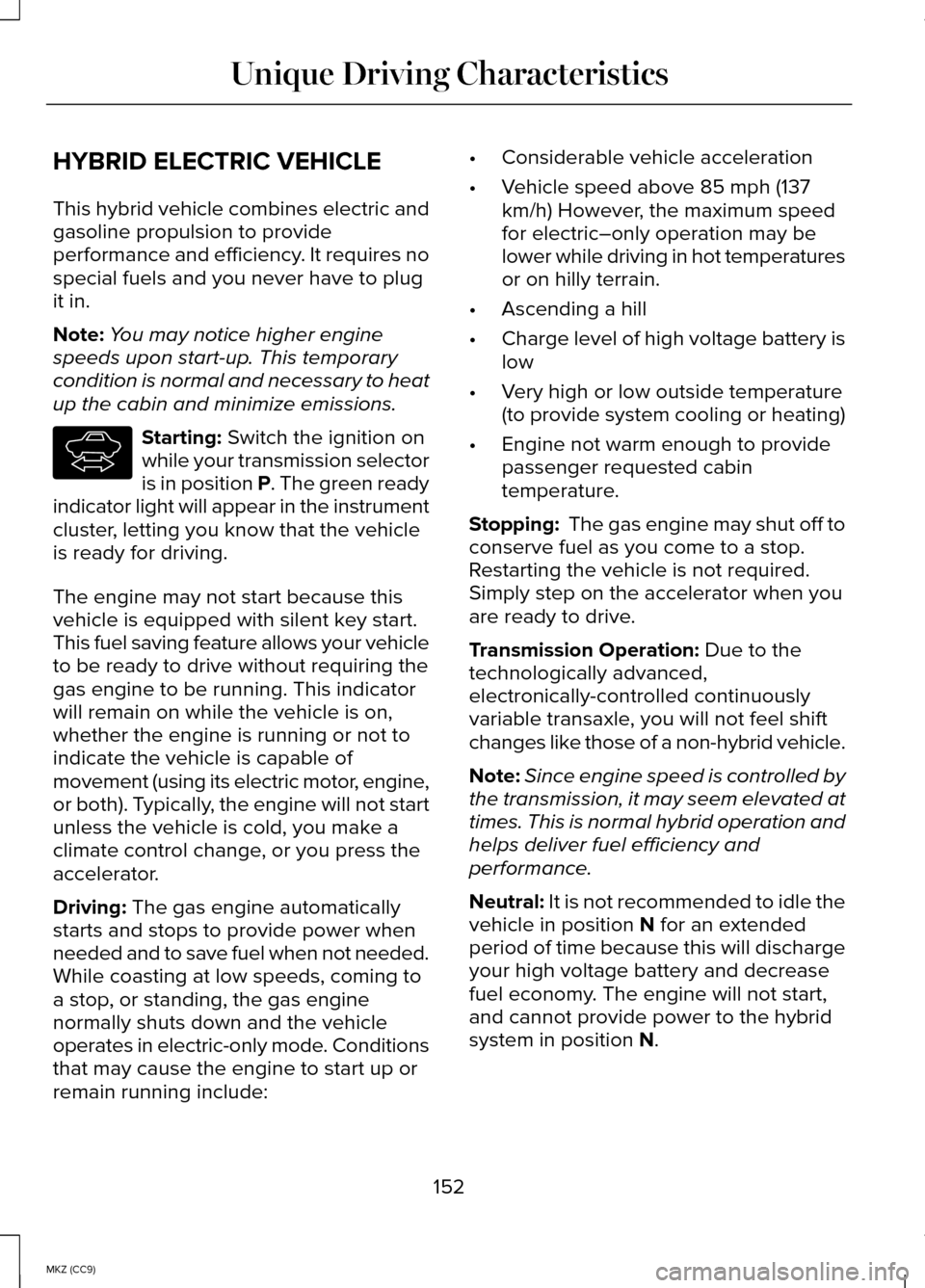
HYBRID ELECTRIC VEHICLE
This hybrid vehicle combines electric and
gasoline propulsion to provide
performance and efficiency. It requires no
special fuels and you never have to plug
it in.
Note:
You may notice higher engine
speeds upon start-up. This temporary
condition is normal and necessary to heat
up the cabin and minimize emissions. Starting: Switch the ignition on
while your transmission selector
is in position P. The green ready
indicator light will appear in the instrument
cluster, letting you know that the vehicle
is ready for driving.
The engine may not start because this
vehicle is equipped with silent key start.
This fuel saving feature allows your vehicle
to be ready to drive without requiring the
gas engine to be running. This indicator
will remain on while the vehicle is on,
whether the engine is running or not to
indicate the vehicle is capable of
movement (using its electric motor, engine,
or both). Typically, the engine will not start
unless the vehicle is cold, you make a
climate control change, or you press the
accelerator.
Driving:
The gas engine automatically
starts and stops to provide power when
needed and to save fuel when not needed.
While coasting at low speeds, coming to
a stop, or standing, the gas engine
normally shuts down and the vehicle
operates in electric-only mode. Conditions
that may cause the engine to start up or
remain running include: •
Considerable vehicle acceleration
• Vehicle speed above 85 mph (137
km/h) However, the maximum speed
for electric–only operation may be
lower while driving in hot temperatures
or on hilly terrain.
• Ascending a hill
• Charge level of high voltage battery is
low
• Very high or low outside temperature
(to provide system cooling or heating)
• Engine not warm enough to provide
passenger requested cabin
temperature.
Stopping:
The gas engine may shut off to
conserve fuel as you come to a stop.
Restarting the vehicle is not required.
Simply step on the accelerator when you
are ready to drive.
Transmission Operation:
Due to the
technologically advanced,
electronically-controlled continuously
variable transaxle, you will not feel shift
changes like those of a non-hybrid vehicle.
Note: Since engine speed is controlled by
the transmission, it may seem elevated at
times. This is normal hybrid operation and
helps deliver fuel efficiency and
performance.
Neutral:
It is not recommended to idle the
vehicle in position N for an extended
period of time because this will discharge
your high voltage battery and decrease
fuel economy. The engine will not start,
and cannot provide power to the hybrid
system in position
N.
152
MKZ (CC9) Unique Driving CharacteristicsE144692
Page 155 of 445
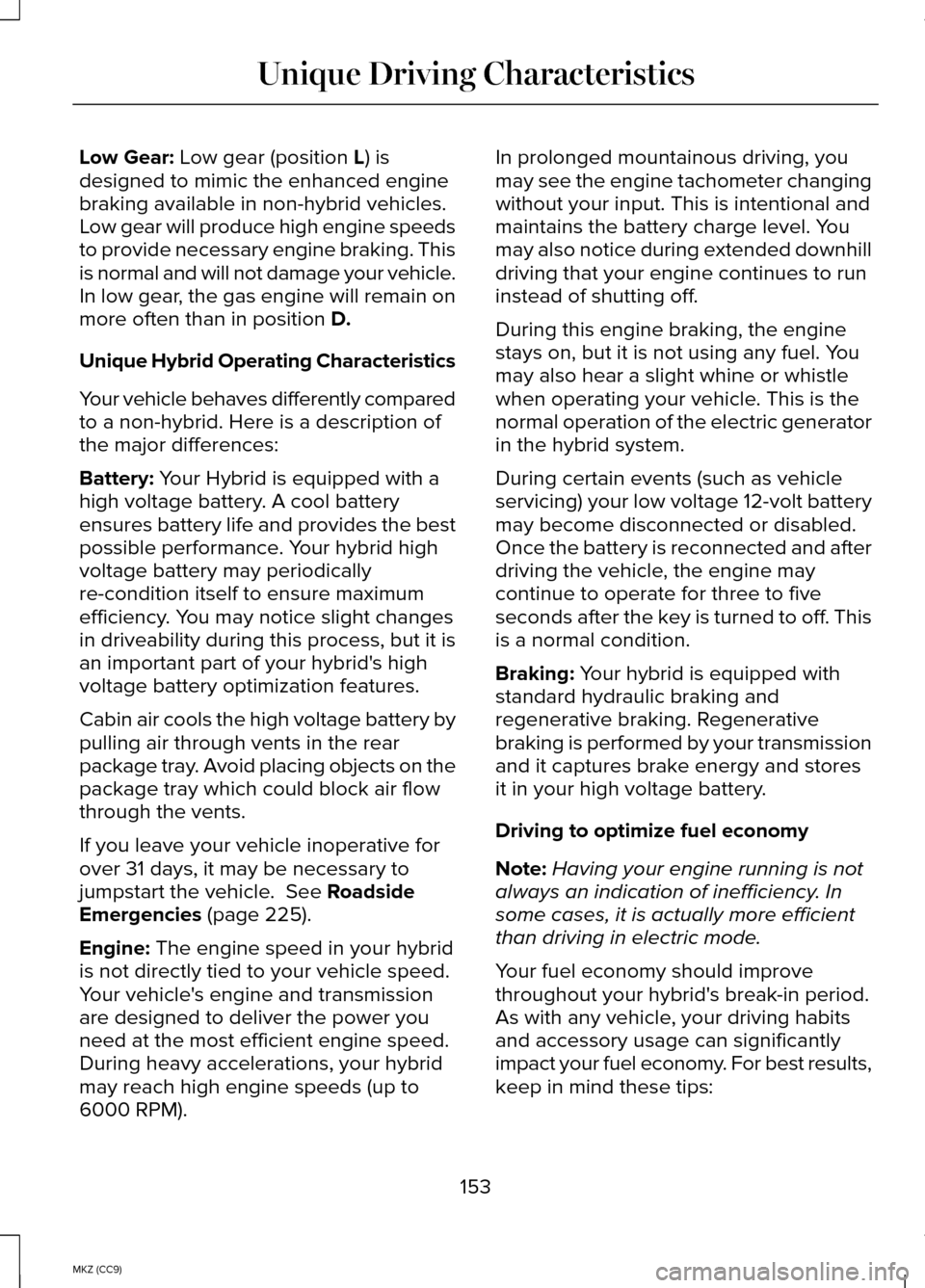
Low Gear: Low gear (position L) is
designed to mimic the enhanced engine
braking available in non-hybrid vehicles.
Low gear will produce high engine speeds
to provide necessary engine braking. This
is normal and will not damage your vehicle.
In low gear, the gas engine will remain on
more often than in position
D.
Unique Hybrid Operating Characteristics
Your vehicle behaves differently compared
to a non-hybrid. Here is a description of
the major differences:
Battery:
Your Hybrid is equipped with a
high voltage battery. A cool battery
ensures battery life and provides the best
possible performance. Your hybrid high
voltage battery may periodically
re-condition itself to ensure maximum
efficiency. You may notice slight changes
in driveability during this process, but it is
an important part of your hybrid's high
voltage battery optimization features.
Cabin air cools the high voltage battery by
pulling air through vents in the rear
package tray. Avoid placing objects on the
package tray which could block air flow
through the vents.
If you leave your vehicle inoperative for
over 31 days, it may be necessary to
jumpstart the vehicle.
See Roadside
Emergencies (page 225).
Engine:
The engine speed in your hybrid
is not directly tied to your vehicle speed.
Your vehicle's engine and transmission
are designed to deliver the power you
need at the most efficient engine speed.
During heavy accelerations, your hybrid
may reach high engine speeds (up to
6000 RPM). In prolonged mountainous driving, you
may see the engine tachometer changing
without your input. This is intentional and
maintains the battery charge level. You
may also notice during extended downhill
driving that your engine continues to run
instead of shutting off.
During this engine braking, the engine
stays on, but it is not using any fuel. You
may also hear a slight whine or whistle
when operating your vehicle. This is the
normal operation of the electric generator
in the hybrid system.
During certain events (such as vehicle
servicing) your low voltage 12-volt battery
may become disconnected or disabled.
Once the battery is reconnected and after
driving the vehicle, the engine may
continue to operate for three to five
seconds after the key is turned to off. This
is a normal condition.
Braking:
Your hybrid is equipped with
standard hydraulic braking and
regenerative braking. Regenerative
braking is performed by your transmission
and it captures brake energy and stores
it in your high voltage battery.
Driving to optimize fuel economy
Note: Having your engine running is not
always an indication of inefficiency. In
some cases, it is actually more efficient
than driving in electric mode.
Your fuel economy should improve
throughout your hybrid's break-in period.
As with any vehicle, your driving habits
and accessory usage can significantly
impact your fuel economy. For best results,
keep in mind these tips:
153
MKZ (CC9) Unique Driving Characteristics
Page 156 of 445
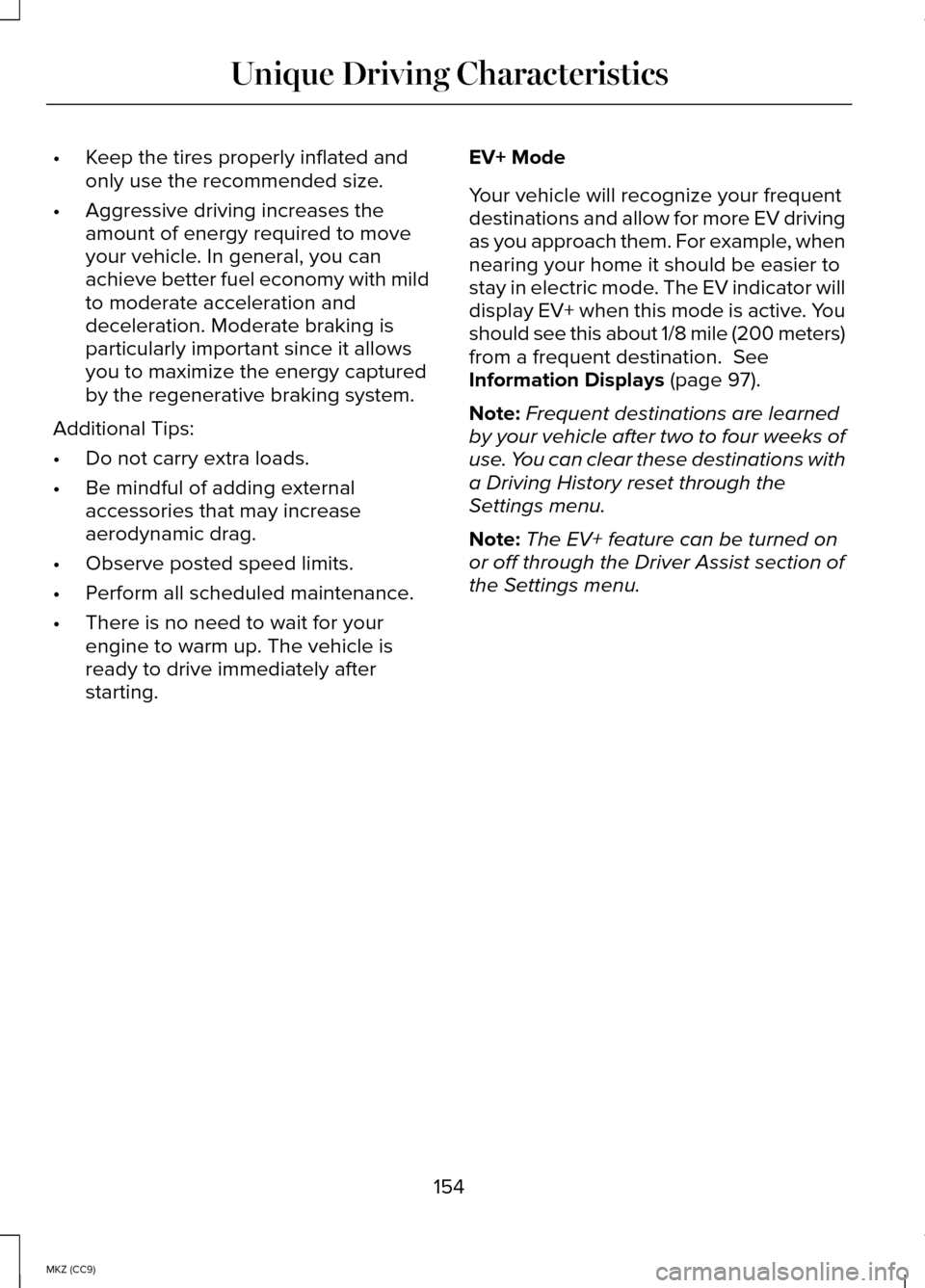
•
Keep the tires properly inflated and
only use the recommended size.
• Aggressive driving increases the
amount of energy required to move
your vehicle. In general, you can
achieve better fuel economy with mild
to moderate acceleration and
deceleration. Moderate braking is
particularly important since it allows
you to maximize the energy captured
by the regenerative braking system.
Additional Tips:
• Do not carry extra loads.
• Be mindful of adding external
accessories that may increase
aerodynamic drag.
• Observe posted speed limits.
• Perform all scheduled maintenance.
• There is no need to wait for your
engine to warm up. The vehicle is
ready to drive immediately after
starting. EV+ Mode
Your vehicle will recognize your frequent
destinations and allow for more EV driving
as you approach them. For example, when
nearing your home it should be easier to
stay in electric mode. The EV indicator will
display EV+ when this mode is active. You
should see this about 1/8 mile (200 meters)
from a frequent destination. See
Information Displays (page 97).
Note: Frequent destinations are learned
by your vehicle after two to four weeks of
use. You can clear these destinations with
a Driving History reset through the
Settings menu.
Note: The EV+ feature can be turned on
or off through the Driver Assist section of
the Settings menu.
154
MKZ (CC9) Unique Driving Characteristics
Page 157 of 445
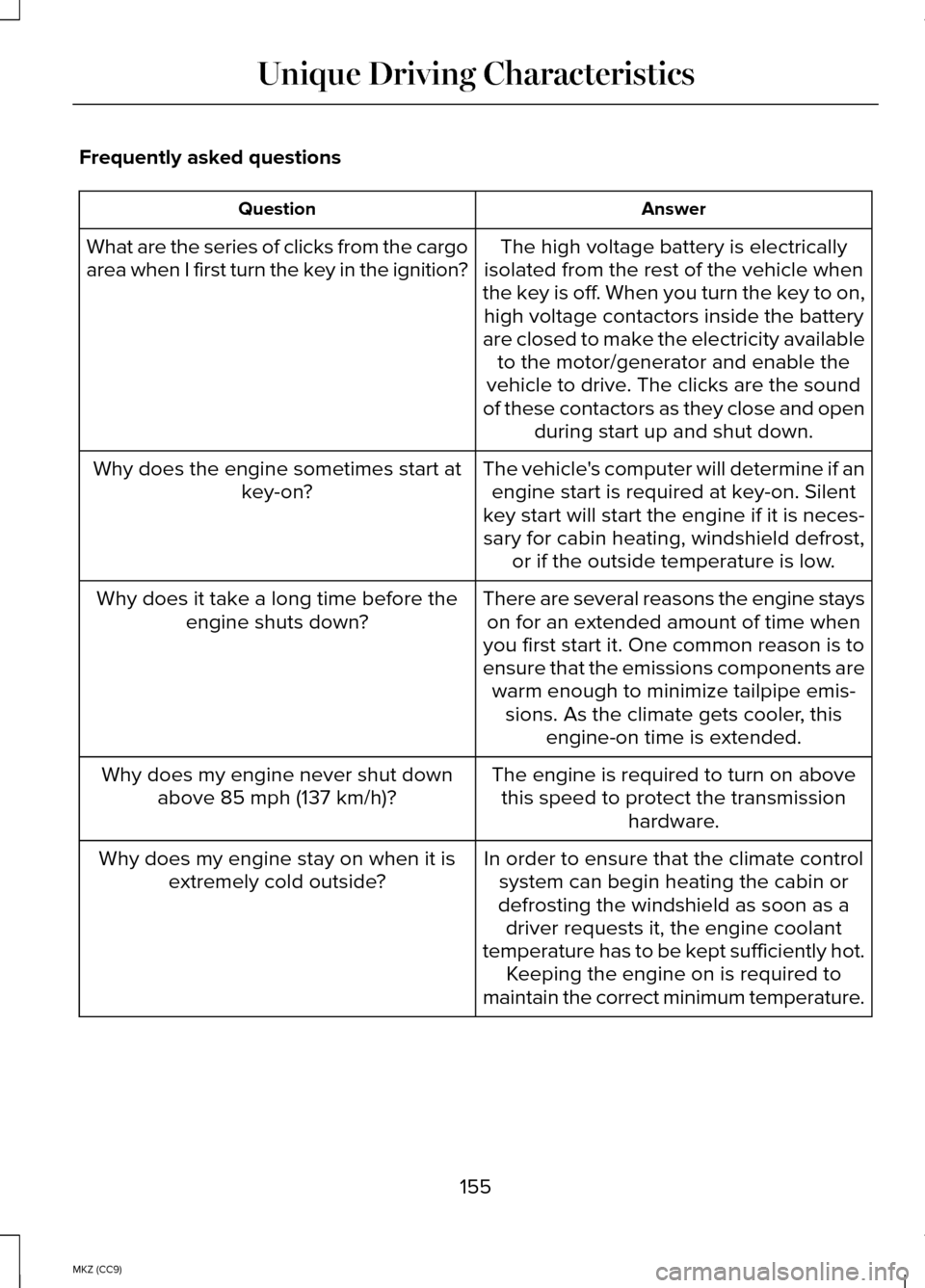
Frequently asked questions
Answer
Question
The high voltage battery is electrically
isolated from the rest of the vehicle when
the key is off. When you turn the key to on, high voltage contactors inside the battery
are closed to make the electricity available to the motor/generator and enable the
vehicle to drive. The clicks are the sound
of these contactors as they close and open during start up and shut down.
What are the series of clicks from the cargo
area when I first turn the key in the ignition?
The vehicle's computer will determine if anengine start is required at key-on. Silent
key start will start the engine if it is neces- sary for cabin heating, windshield defrost, or if the outside temperature is low.
Why does the engine sometimes start at
key-on?
There are several reasons the engine stayson for an extended amount of time when
you first start it. One common reason is to
ensure that the emissions components are warm enough to minimize tailpipe emis- sions. As the climate gets cooler, this engine-on time is extended.
Why does it take a long time before the
engine shuts down?
The engine is required to turn on abovethis speed to protect the transmission hardware.
Why does my engine never shut down
above 85 mph (137 km/h)?
In order to ensure that the climate controlsystem can begin heating the cabin or
defrosting the windshield as soon as a driver requests it, the engine coolant
temperature has to be kept sufficiently hot. Keeping the engine on is required to
maintain the correct minimum temperature.
Why does my engine stay on when it is
extremely cold outside?
155
MKZ (CC9) Unique Driving Characteristics
Page 158 of 445
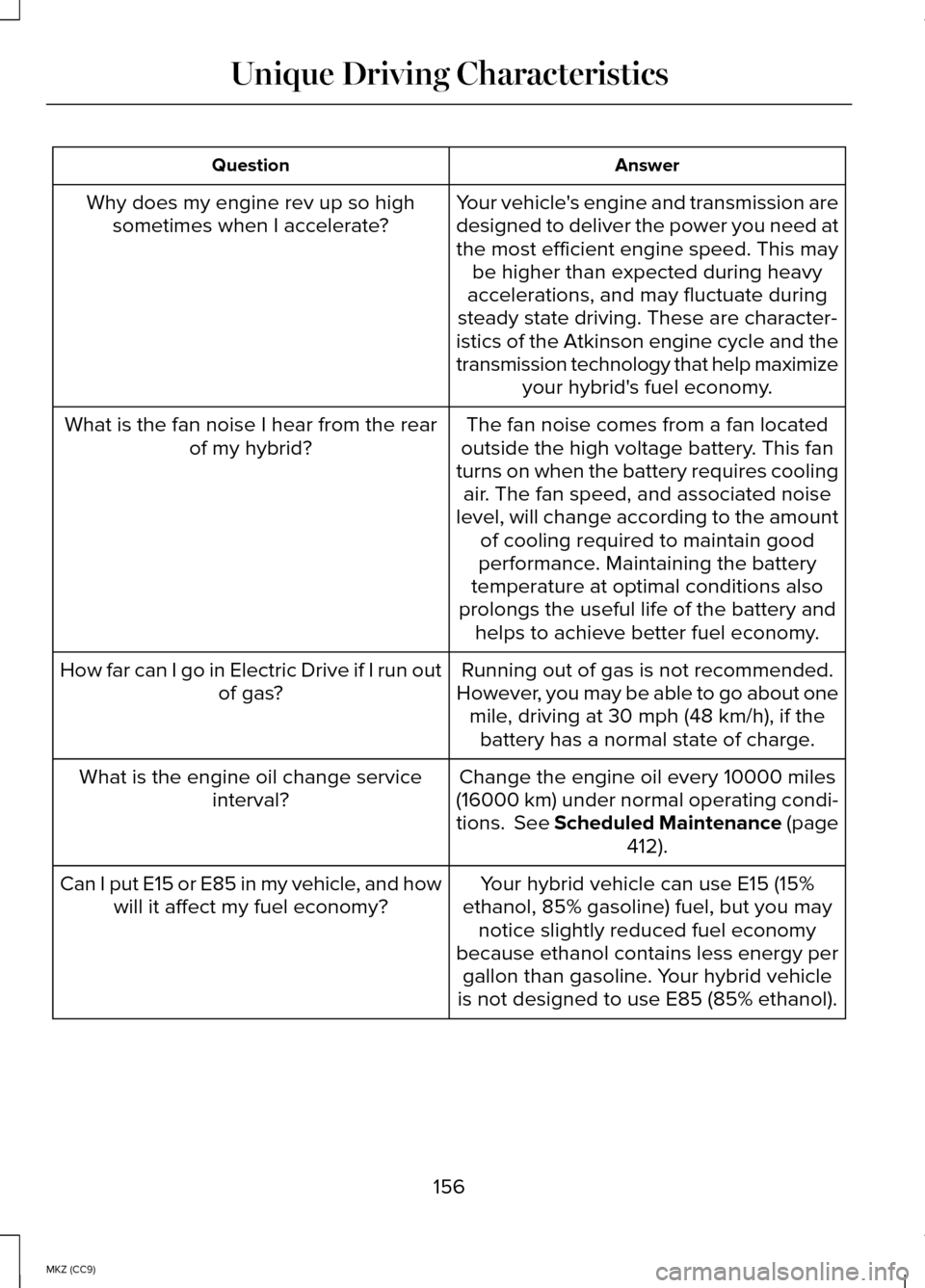
Answer
Question
Your vehicle's engine and transmission are
designed to deliver the power you need atthe most efficient engine speed. This may be higher than expected during heavy
accelerations, and may fluctuate during
steady state driving. These are character-
istics of the Atkinson engine cycle and the
transmission technology that help maximize your hybrid's fuel economy.
Why does my engine rev up so high
sometimes when I accelerate?
The fan noise comes from a fan located
outside the high voltage battery. This fan
turns on when the battery requires cooling air. The fan speed, and associated noise
level, will change according to the amount of cooling required to maintain good
performance. Maintaining the battery
temperature at optimal conditions also
prolongs the useful life of the battery and helps to achieve better fuel economy.
What is the fan noise I hear from the rear
of my hybrid?
Running out of gas is not recommended.
However, you may be able to go about one mile, driving at 30 mph (48 km/h), if thebattery has a normal state of charge.
How far can I go in Electric Drive if I run out
of gas?
Change the engine oil every 10000 miles
(16000 km) under normal operating condi-
tions. See Scheduled Maintenance (page
412).
What is the engine oil change service
interval?
Your hybrid vehicle can use E15 (15%
ethanol, 85% gasoline) fuel, but you may notice slightly reduced fuel economy
because ethanol contains less energy per gallon than gasoline. Your hybrid vehicle
is not designed to use E85 (85% ethanol).
Can I put E15 or E85 in my vehicle, and how
will it affect my fuel economy?
156
MKZ (CC9) Unique Driving Characteristics
Page 159 of 445
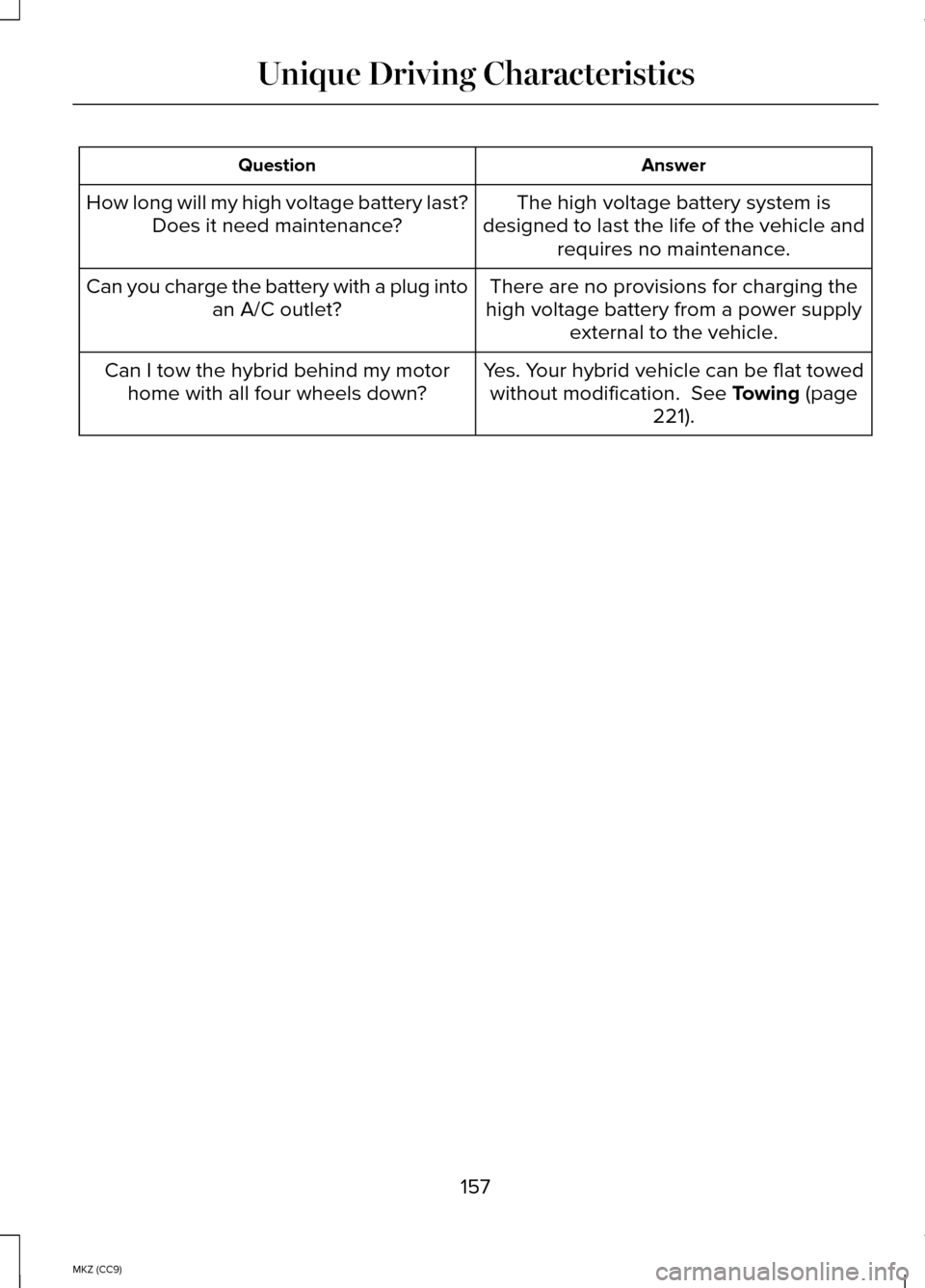
Answer
Question
The high voltage battery system is
designed to last the life of the vehicle and requires no maintenance.
How long will my high voltage battery last?
Does it need maintenance?
There are no provisions for charging the
high voltage battery from a power supply external to the vehicle.
Can you charge the battery with a plug into
an A/C outlet?
Yes. Your hybrid vehicle can be flat towedwithout modification. See Towing (page
221).
Can I tow the hybrid behind my motor
home with all four wheels down?
157
MKZ (CC9) Unique Driving Characteristics
Page 160 of 445
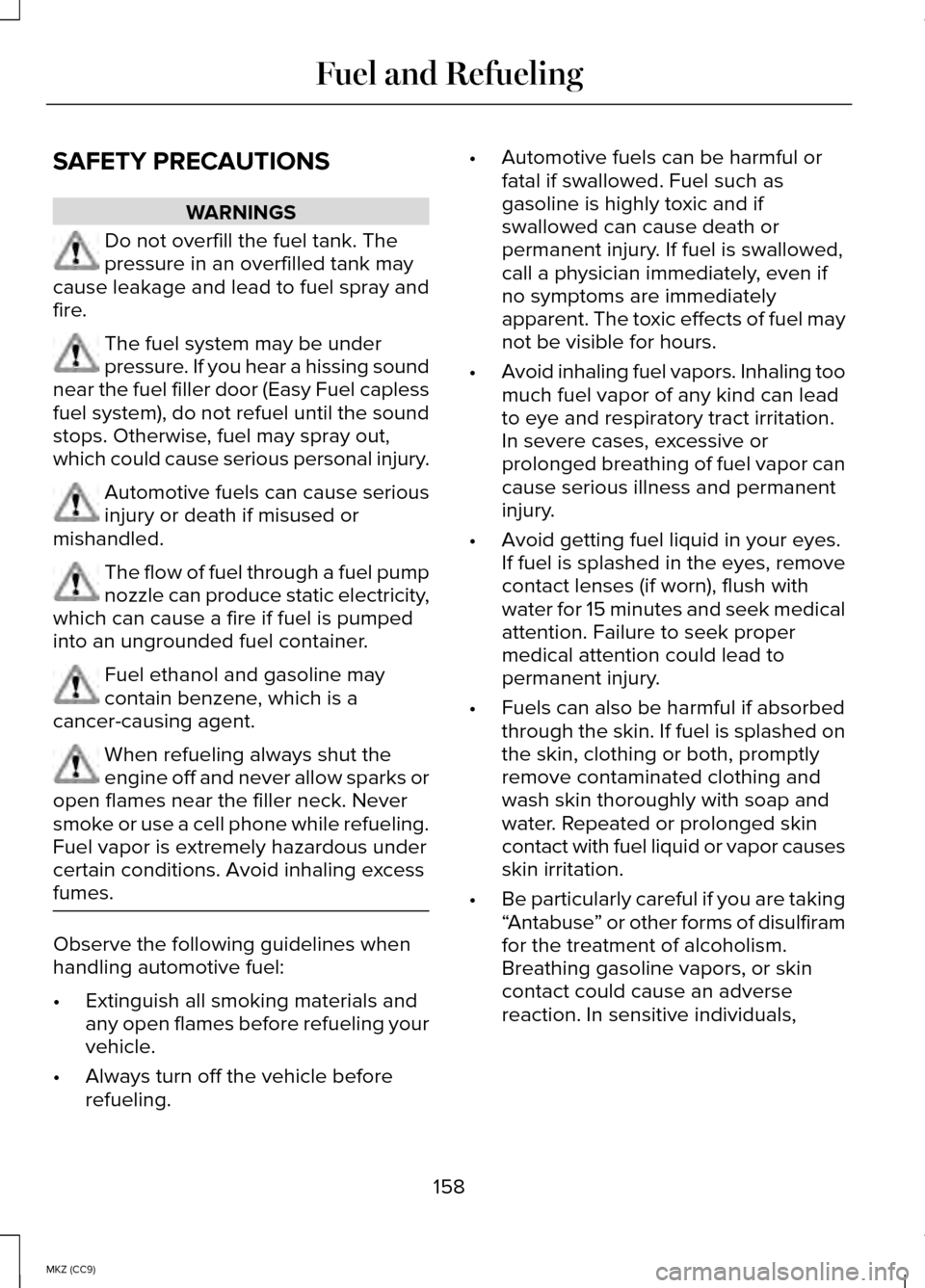
SAFETY PRECAUTIONS
WARNINGS
Do not overfill the fuel tank. The
pressure in an overfilled tank may
cause leakage and lead to fuel spray and
fire. The fuel system may be under
pressure. If you hear a hissing sound
near the fuel filler door (Easy Fuel capless
fuel system), do not refuel until the sound
stops. Otherwise, fuel may spray out,
which could cause serious personal injury. Automotive fuels can cause serious
injury or death if misused or
mishandled. The flow of fuel through a fuel pump
nozzle can produce static electricity,
which can cause a fire if fuel is pumped
into an ungrounded fuel container. Fuel ethanol and gasoline may
contain benzene, which is a
cancer-causing agent. When refueling always shut the
engine off and never allow sparks or
open flames near the filler neck. Never
smoke or use a cell phone while refueling.
Fuel vapor is extremely hazardous under
certain conditions. Avoid inhaling excess
fumes. Observe the following guidelines when
handling automotive fuel:
•
Extinguish all smoking materials and
any open flames before refueling your
vehicle.
• Always turn off the vehicle before
refueling. •
Automotive fuels can be harmful or
fatal if swallowed. Fuel such as
gasoline is highly toxic and if
swallowed can cause death or
permanent injury. If fuel is swallowed,
call a physician immediately, even if
no symptoms are immediately
apparent. The toxic effects of fuel may
not be visible for hours.
• Avoid inhaling fuel vapors. Inhaling too
much fuel vapor of any kind can lead
to eye and respiratory tract irritation.
In severe cases, excessive or
prolonged breathing of fuel vapor can
cause serious illness and permanent
injury.
• Avoid getting fuel liquid in your eyes.
If fuel is splashed in the eyes, remove
contact lenses (if worn), flush with
water for 15 minutes and seek medical
attention. Failure to seek proper
medical attention could lead to
permanent injury.
• Fuels can also be harmful if absorbed
through the skin. If fuel is splashed on
the skin, clothing or both, promptly
remove contaminated clothing and
wash skin thoroughly with soap and
water. Repeated or prolonged skin
contact with fuel liquid or vapor causes
skin irritation.
• Be particularly careful if you are taking
“Antabuse ” or other forms of disulfiram
for the treatment of alcoholism.
Breathing gasoline vapors, or skin
contact could cause an adverse
reaction. In sensitive individuals,
158
MKZ (CC9) Fuel and Refueling